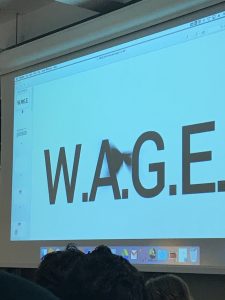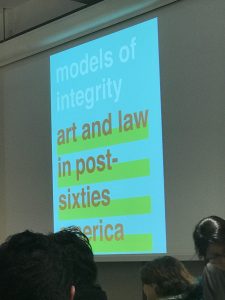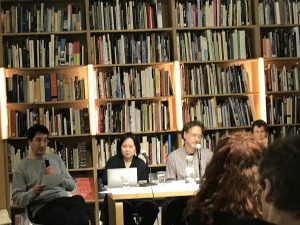On March 18th, I went to a lecture called Experimental Ethics in Art. It is located on 132 West 21st Street and it is part of the School of Visual Arts. This lecture shows how the tools in finance and algorithm decide how art and design would circulate the world. It consisted of a panel of three professionals and was moderated Brain Kuan Wood. The panelist are Joan Kee, Lise Soskolne and Jonathan Beller. I went there because I personally thought it was important to learn how culture and the economy play a role in design. When I left the lecture, I felt like I’ve learned a lot.
Joan Kee is the author of Models of Integrity: Art and Law in Post-Sixties America. She focuses on modern and contemporary art from multiregional perspectives In the lecture, Kee talks about the historical and legal analysis of art and how they can offer insights of problems that have a wide currency, such as social behavior. She discussed how artists engaged with the American law from the early 1970’s to the mid 1990’s. This was considered the time significant legal changes profoundly affected daily life. It was interesting to learn about this because shows how artist are using art to depict the issues that was going on in society between the 1970’s and the 1990’s. This would be especially true today because artists are using their artworks to call out all of the negative things that is happening in society. So it was really great that I’ve gotten to learn about that.
Lise Soskolne is an artist who is also the core organizer of W.A.G.E, which stands for Working Artists and the Greater Economy. W.A.G.E is an activist organization whose mission is to establish sustainable economic relationships between artists and the institution that contract their labor, as well as to introduce mechanism for self-regulation into the art field that bring out a more equitable distribution of its economy. Soskolne explains that artists author their own political dissent, so it is not a one size fits model. Each artwork can be circulated with its own political criteria or none at all. W.A.G.E, she explains, acts as a third party or host but the use of contract is inherently grounded in shared politics of labor. So in order to access the platform, contract users have to join WAGENCY, which is used to transact artists’ labor. It would enable anyone supplying content for the programs of nonprofit institutions registered in the U.S to send request for compensation with the option of withholding content when the standards are not met. I think W.A.G.E is a fair organization that would help artists like myself.
Jonathan Beller is a theorist who focuses on the visual turn and the attention economy. In the lecture he discusses about ArtWork, which is a project being used to end racial capitalism. It enables the creativity of the oppressed to realize a vision of social equality in the world, builds traditional forms of culture-making , and reprograms the economic dimensions through decentralized protocols of ownership distribution and communication. The project is embarking on revolutionary strategy by supporting alternative social activism and issuing secure equity holdings on the blockchain. Beeler explains the ArtWork combines art with work, the socio-cybernetic network, and the financial architecture to scale the demands for change, all for reparations. I feel like this is a very important project for all people because it would bring us one step closer to diversity within our society.
Even though the panel was a great experience, the networking did not go as well as I would like. No one had business cards to give to me. Most of the people did not have business cards on them. When the lecture was over, a majority of the people were already gone, so I did not get to speak with a lot of people. I spoke with the panelists and they were very nice to me. I told them thank you for the panel and the presentations because I thought they were very important to learn as a designer. Even though they did not have business cards to hand me, they told me I can find out more information on each of their respective websites. I also spoke with some of the few people who stayed behind for a little bit, some were pleasant and some were not.
I spoke with one woman in particular who was attending the event. She was very friendly and we introduced each other. I asked her if she enjoyed the event and she said yes. When I asked her what has brought her there to the event, she told me that one of her friends brought her there. Assuming that she was in the art field, I asked the lady what does she do. To my surprise, she told me that she was actually studying nursing. It was nice to see that someone outside of the art field can come to an graphic design event and enjoy it. It shows that even if you are not in the design field, you can still appreciate art and design as a job and respect they way we express ourselves. In my opinion, artists and designers are showing the world from our point of view, so it is great to see that it is being respected as a career.
There was a group of three women and I tried to start a conversation with them. I asked them how was the lecture. Two of the those ladies were nice and said that they enjoyed it, but the other one seemed rather annoyed with me for some reason. I tried to introduce myself but she cut me off saying “Okay” and she kind of gave me a dirty look. After that she turned to her group, and they started talking about something else. I even saw the two nice ladies feeling somewhat bad for me. I was a little thrown off by that woman’s actions, but I was not discouraged by her because I am learning to take rejection easily. So I could say that that particular moment was a learning experience as well.
Despite the networking not going very well, I still enjoyed the event. The panel was great and very professional. They discussed very important issues in terms of how artists play a role in cultural society and how they use the financial tools make the decisions on who can own, modify and view an artwork. As an artist, I felt like I needed to learn about art as platform for social justice and how the economy would work when it comes to artists, graphic designers, photographers, and freelancers. I would recommend a lecture like this to anyone because they can learn a lot form it.





